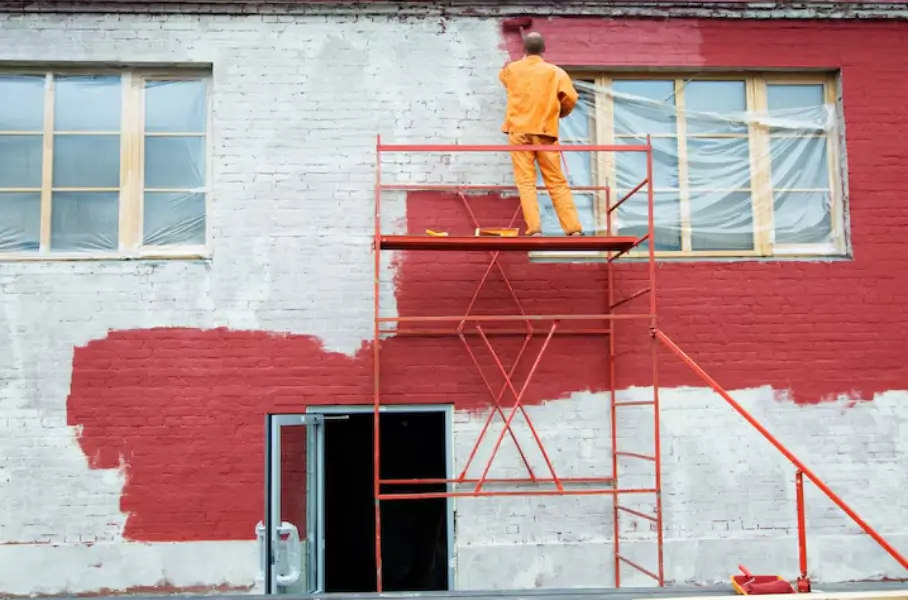Weather conditions profoundly affect the success of exterior painting and siding installation projects. Temperature, humidity, precipitation, and wind all influence material performance, installation quality, and project longevity. Understanding these impacts helps homeowners and contractors schedule work appropriately and avoid costly failures from weather-related complications.
Temperature Effects on Exterior Projects
Temperature affects every aspect of exterior painting and siding installation. Paint requires specific temperature ranges for proper application and curing. Most paints need temperatures between 50°F and 90°F, with the ideal range being 60°F to 80°F. Below minimum temperatures, paint becomes thick and difficult to apply, while chemical reactions necessary for proper curing slow or stop entirely.
Extreme heat creates different challenges for painting projects. High temperatures cause paint to dry too quickly, preventing proper flow and leveling. Brush marks remain visible, and the paint film may not properly bond to surfaces. Painters working in hot conditions must adjust techniques, working in smaller sections and maintaining wet edges to achieve professional results.
Siding installation faces temperature-related challenges as well. Vinyl siding expands and contracts significantly with temperature changes. Installers must account for this movement by leaving appropriate gaps at joints and connection points. Installing vinyl siding in extreme cold risks cracking, while installation in extreme heat may result in buckling when temperatures drop.
Humidity’s Role in Project Success
Humidity levels critically impact exterior painting outcomes. High humidity slows paint drying and curing, extending the time paint remains vulnerable to damage. In extreme cases, moisture in the air can prevent paint from properly adhering to surfaces, leading to premature failure. Relative humidity above 85% generally makes painting inadvisable.
Low humidity presents different challenges. In arid conditions, paint may dry too quickly, similar to high-temperature effects. This rapid drying prevents proper film formation and can lead to poor adhesion. Painters must adjust their techniques and possibly their product choices when working in very dry conditions.
Siding materials respond differently to humidity levels. Wood siding absorbs moisture from humid air, causing expansion that installers must accommodate. Fiber cement siding remains more stable but still requires proper acclimation to local humidity levels before installation. Failure to account for humidity-related movement leads to gaps, buckling, or stress cracks.
Precipitation & Moisture Concerns
Rain represents the most obvious weather threat to exterior projects. Fresh paint needs time to cure before exposure to moisture. Most paints require at least 24 hours of dry weather after application, though some quick-dry formulations reduce this window. Even light mist or heavy dew can damage uncured paint, causing streaking, spotting, or complete failure.
Surface moisture before painting creates adhesion problems. Surfaces must be completely dry before paint application. Morning dew, recent rain, or even high humidity can leave invisible moisture on surfaces. Professional painters use moisture meters to verify surface dryness, especially on porous materials like wood or masonry.
Siding installation continues during light rain, but moisture creates complications. Wet conditions make surfaces slippery, increasing safety risks. Water can also interfere with caulking and sealing operations essential for weatherproof installation. Some adhesives and sealants specifically prohibit application to wet surfaces, potentially compromising the installation’s integrity.
Wind Considerations
Wind affects exterior painting through several mechanisms. Strong winds accelerate paint drying, potentially causing the same problems as high temperatures. Wind-blown dust and debris can stick to wet paint, creating texture problems and contamination. Spray painting becomes nearly impossible in windy conditions, as overspray travels far beyond intended surfaces.
Safety concerns multiply in windy conditions. Ladders become unstable, and workers face increased risk of falls. Drop cloths and plastic sheeting blow around, potentially damaging fresh paint or landscaping. Professional contractors often suspend work when winds exceed certain speeds, typically around 15-20 mph for painting operations.
Siding installation in the wind requires extra precautions. Large siding panels act like sails, making handling difficult and dangerous. Wind can tear panels from workers’ hands or cause them to impact other surfaces. Precision work like cutting and fitting becomes challenging when materials move unpredictably in gusty conditions.
Seasonal Considerations
Spring offers generally favorable conditions for exterior projects but comes with challenges. Temperature fluctuations between day and night can stress fresh paint. Spring rains require flexible scheduling and constant weather monitoring. Pollen can contaminate wet paint, creating surface defects. However, moderate temperatures and increasing daylight hours make spring popular for exterior work.
Summer heat and humidity dominate project planning in many regions. Work often starts early to avoid afternoon heat. Paint selection shifts toward products formulated for high-temperature application. Siding installation continues but requires attention to expansion allowances. Summer thunderstorms can arrive quickly, necessitating rapid work protection.
Fall provides ideal conditions in many climates. Moderate temperatures, lower humidity, and reduced precipitation create optimal painting weather. However, shortening days limit work hours. Falling leaves can stick to wet paint, requiring extra site maintenance. Early winter storms may arrive unexpectedly, making schedule padding essential.
Material-Specific Weather Responses
Different siding materials respond uniquely to weather conditions during installation. Vinyl siding’s thermal movement requires temperature-specific spacing. Cold-weather installation uses wider gaps to accommodate expansion in summer heat. Fiber cement siding proves more stable but becomes brittle in extreme cold, increasing breakage risk during cutting and handling.
Wood siding installation depends heavily on moisture content. Installing wet wood guarantees future problems as it shrinks while drying. Conversely, extremely dry wood may split or crack when exposed to normal humidity levels. Proper acclimation and moisture testing prevent these issues but require planning and patience.
Paint formulations vary in weather tolerance. Acrylic latex paints generally handle temperature variations better than oil-based paints. Some manufacturers offer specific hot-weather or cold-weather formulations. Understanding these options helps contractors select appropriate products for prevailing conditions.
Planning Around Weather
Successful exterior projects require flexible scheduling that accommodates weather uncertainties. Professional contractors build weather delays into project timelines, setting realistic expectations with clients. They monitor extended forecasts while recognizing that weather predictions beyond a few days remain unreliable.
Material storage becomes critical when weather delays occur. Paint must be protected from temperature extremes that could cause separation or spoilage. Siding materials need protection from moisture and UV exposure. Proper storage areas prevent material damage during weather-related work stoppages.
Communication with clients about weather impacts prevents frustration and misunderstandings. Explaining why work cannot proceed in certain conditions helps clients appreciate the importance of weather-appropriate scheduling. This education often leads to better project outcomes and satisfied customers.
Long-Term Weather Effects
Initial installation quality directly impacts how exterior painting and siding withstand future weather exposure. Projects completed in ideal conditions typically last longer than those rushed during marginal weather. The extra time and cost of waiting for proper conditions pay dividends through extended service life.
Different climates age exterior surfaces at varying rates. Coastal areas with salt air accelerate coating degradation. High-altitude locations with intense UV exposure break down paint faster. Understanding local weather patterns helps predict maintenance needs and select appropriate materials.
Climate change introduces new variables into project planning. Increasing temperature extremes, shifting precipitation patterns, and more frequent severe weather events affect both installation scheduling and long-term performance expectations. Forward-thinking contractors adapt their practices to these evolving conditions.
Weather profoundly influences every aspect of exterior painting and siding installation. Success requires understanding these impacts and planning accordingly. By respecting weather’s role and working within nature’s constraints, contractors deliver projects that protect and beautify homes for years to come.

